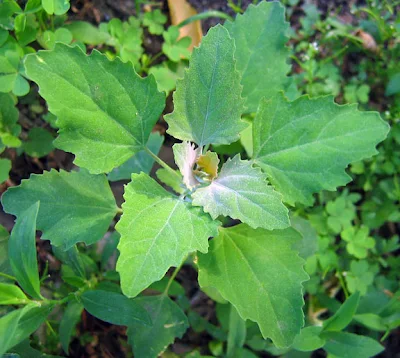Expedition Pit
One of the three new tree pits, one year after creation, filling in nicely with an assortment of plants.
Of course, we have the usual suspects, like mugwort, Artemisia vulgaris.
And smartweed, Polygonum caespitosum.
But then there is this toothier, lamb's quarter look-a-like that I suspect is an amaranthus spp.

This basal growth seems to have form, some cultivated history perhaps?

This basal growth seems to have form, some cultivated history perhaps?
And this? Clearly the same as the above, but older. Silvery green, lanceolate foliage, upright habit, flower buds forming. It looks special -to me, and worth protecting to see what shall come of it.
But should I be surprised at all that one of my most prolifically self-seeding asters has shown up in droves just across three feet of sidewalk? Hardly. But exciting, nonetheless, because I am witness to a logic in its regeneration -it sprouts primarily at the interface between the concrete and the soil. Had the seeds washed or blown across the sidewalk, or both?
Nor should I be surprised that another prolifically spreading garden plant (an accepted weed), Persian Speedwell, Veronica persica, should have made it across the hot, concrete sidewalk plains of New York City.
So why is that I was utterly shocked to see my garden phlox growing in the tree pit? And why does it feel that if I was to pull all the unaccepted weeds, yet leave the accepted, only then would they get stepped on? It seems that if I leave all the weeds, all will survive and flourish. Does the plant community defend itself simply by appearances? Maybe people only see jumble and avoid it, naturally, as city folks are wont to do?
Yet, in avoiding, they miss out on little gems like this.
A snapdragon?
And this.
Possibly Viola arvensis, European Field Pansy.
What I enjoy in the pits is the sense of surprise, which isn't inherent to my cultivated garden, except where I forget what I planted or when something grows off plan. I think it is important to see what takes naturally to bare soil, to help understand soil, and the movement of offspring, and fecundity, to find flowers where there appears to be none, and to appreciate what follows us from there to here.
But please, don't let it get out of hand, as is this curbside stand of curly dock, Rumex crispus, across the street. Eventually, one or two of those species will overtake the rest, allowing only a simple succession of one or two cool and warm weather weeds to flourish.

















Pretty rose and I really enjoyed the post. (Though admittedly, I'm a nerd who enjoys identifying the weeds and whatnot too, so my opinion is a bit biased.)
ReplyDelete